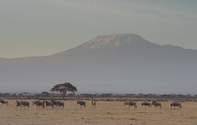
Kilimanjaro's snowy crown is fast disappearing, as predicted by experts several years ago. This means not just the loss of the tourist attraction of snow at the equator, but also less water for people lower down the mountain who rely on meltwater from Kilimanjaro's glaciers to feed their springs. Ohio State University researchers have found that between 1962 and 2002 the ice fields dropped by at least 17 metres.
Since 2002, a 50-metre high wall of ice has retreated at least five metres; a hole will make the Furtwangler glacier split in half this year; another hole will soon split the northern ice sheet in two; and between two and five metres of ice have been lost from the surfaces of various ice sheets, one of which is only nine metres thick to begin with. Researcher Lonnie Thompson says, "There has been no accumulation of new ice forming on any of those ice fields since 2000. That's an enormous amount of ice lost."
The researchers are currently taking water samples to try and find out how much of the water used in the lowlands is derived from Kilimanjaro's snows. This will help determine how drastic the loss of all the ice will be for the people living there. Thomson initially predicted that all of Kilimanjaro's ice would be gone between 2015 and 2020, but he now believes it may happen even sooner than that.

